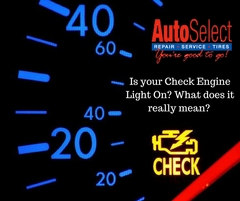
If your check engine light comes on, it can give you a feeling of dread. Is something about to go wrong? How much is it going to cost? Don't panic — let's look at why the light might be on and what to do about it. Keep reading below to get an idea of what might be wrong.
The check engine light illuminates when your vehicle's computer believes there is a problem that could affect — or is affecting — your car's emissions control system.



When the light comes on, one or more diagnostic trouble codes are stored in the car's computer. These codes will stay there even if the light goes out. To address a check engine light issue, you or your mechanic can retrieve the codes by using an OBD-II scanner and then troubleshooting to find the problem.
If your light is on, it typically means the car's emissions control system is faulty and the vehicle is polluting the air beyond allowable federal standards. A vehicle in this condition would fail an emissions inspection or smog check.
Don't confuse the check engine light with the maintenance or service light. These lights illuminate when a routine service is due. They are usually triggered by mileage, gallons of gasoline consumed, or some other type of vehicle-use measurement.
Get it diagnosed by a professional
What to do when your check engine light comes on
Not all check engine light warnings are created equal. Here are four common scenarios, and what they mean:
1. The check engine light comes on only in certain conditions, or flickers.
If the check engine light comes on in the city but goes off on the freeway, then the problem is only happening in city driving conditions. It also might flicker inconsistently. Pay attention to whether or not the vehicle runs or drives any differently when you see the light. If you notice a difference, drive the car as little as possible and take it to your mechanic. If there's no change in vehicle performance, you can drive home, but have it inspected as soon as possible. In this condition, you run a risk of the vehicle dying or not starting.
2. The check engine light comes on and stays on.
If the check engine light is on constantly during driving with no noticeable driving or performance problems, there is a permanent fault in the emission control system. When this happens, the computer that controls the emissions system will usually make it so your car runs only in a few lower gears — this is known as "limp-home mode." You should get the car serviced as soon as possible.
3. The check engine light illuminates, stays on, and there are performance problems.
This means that a vital component of your emission control and engine management system has a serious problem. It usually involves a component or system needed for the vehicle to run at all. In many cases, the vehicle is not safe to drive at all — it could stop or stall out at any moment. It's best to pull over to a safe place and have the vehicle towed to a repair shop for a thorough inspection.
4. The check engine light comes on and blinks in a steady pattern while driving.
Don't confuse this steady pulsing of the check engine light (usually one or more flashes per second) with a flicker (see above). The check engine light may stay on steadily or it may flash when the vehicle is accelerated. This is very serious. There is a severe failure of the emission control system that is causing the engine to misfire to the point that the catalytic converter is damaged each time the check engine light flashes. It may mean that the catalytic converter is overheating to the point that it will glow red or, in extreme cases, start a fire on the underside of the vehicle. Immediately pull over to a safe place and have your vehicle towed to an automotive diagnostician for repair.
Common causes of a check engine light
A number of problems can cause your check engine light to come on, but some are more common than others. To properly identify your issue, consult your mechanic or consider purchasing an ODB-II code reader.
- Gas cap is loose: Tighten the gas cap. If you've lost it, replace it with a new one.
- Oxygen sensor is bad: You'll need a new sensor — but identify which one is bad first.
- Spark plugs may be fouled or failing: Replace the spark plugs.
- Spark plug wires are bad: Try replacing the spark plug wires.
- Catalytic converter is faulty: Have a mechanic inspect and possibly replace the device.
- Mass airflow sensor is bad: You'll need a new sensor.